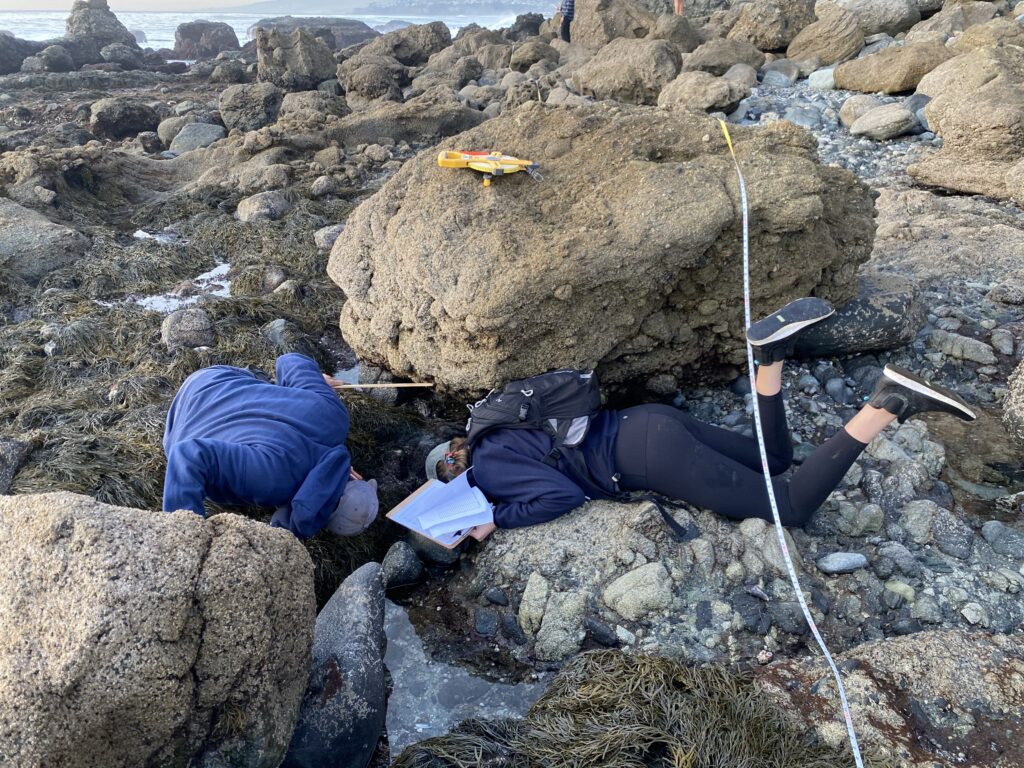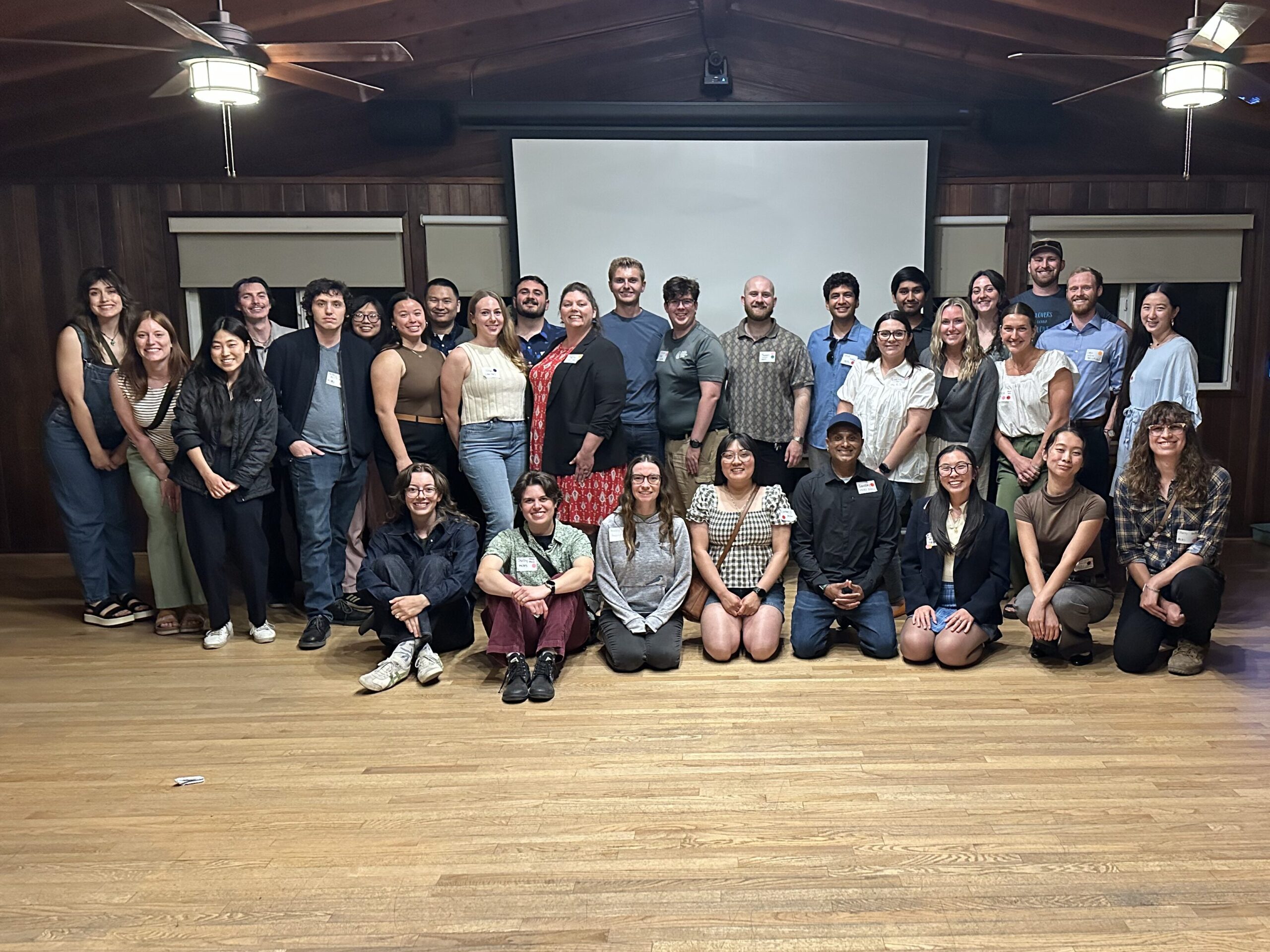Student Blog: Khai Dang
What is your perspective on Black Abalone?
This is a summary of our project prospectus written as a story. Citations are provided for incorporated facts. The characters and the stories are fictional; however, I hope that you can identify with at least part of the story or the character because you may have experienced one or more phases of Henry’s life.
Introduction
Figure 1: A beautiful sunset

The sky is a wave of concentric circles of red to yellow gradient and the glistening waves are reflecting light from the sun slowly dropping below the horizon. The sea surface is reflecting the fiery sky. Ten-year-old Henry is watching the sunset with his parents. He has always loved the annual tent-camping trip on the beach with his parents.
Henry wakes up early the next day and takes an early walk on the beach. From afar, he sees an indigenous woman holding a large shell with something burning inside. Henry curiously approaches the woman and asks what she is doing.
“I am praying to my ancestor,” says the lady.
She explains to Henry that in her tribe, people burn bundles of white sage in abalone shells, then they raise the shell from east to west as they are saying their prayers. They believe the smoke of the sacred sage will carry their prayer into the sky reaching the creator (Hall, 2014).
As a ten-year-old kid, Henry is only interested in the shell with shimmering pink, blue, green, and yellow iridescence. The lady tells him that it is a black abalone shell, and that black abalone are edible. The answer surprises Henry because the last time his Mom tried to cook abalone; the texture was so chewy that it felt like chewing tires. The lady suggests that they can collect some black abalone together. Coastal tribes love black abalone because they live in the rocky intertidal zone which makes them easy to find, and she will show him how to cook abalone probably.
Black Abalone: Both Nutrition and Culture Rich
With his parents’ permission, Henry goes to the lady’s house nearby to cook abalone. He is excited; this will be the first time he sees a tribal house in real life. Unlike what he imagined; the house is just a modern home. However, there are so many strange artifacts, things that Henry has never seen before. Yet, the thing that catches his attention the most is that the house is full of wind chimes made from shells with glimmering pink, blue, green, and yellow iridescence.
As they are waiting for the abalone to cook, the lady starts to tell Henry stories of her people. She tells him the story of the ceremonial dress that has its own song and soul. A dress made from patching multiple abalone shells so that when the wearer moved, it made sounds unique to the dress (Vileisis, 2020). At that moment, a wind starts to blow, and all the wind chimes begin to sing to the rhythm of the wind. For the first time, Henry notices that each wind chime made unique sounds, and all together they played a one-of-the-kind orchestra. He imagines that must be how it sounded when indigenous people dancing in those ceremonial dresses he just heard about.
The abalone was ready, so he tries the dish. The texture reminds him of scallops, but the taste is different, unlike anything he has eaten before. It is briny but not too salty and somewhat buttery. He takes some back to his parents and from that day on, they add a new tradition to their tent camping trips. In his annual tent-camping trips, Henry spends quality time with his family gathering black abalones because they live in the rocky intertidal zone which makes them easy to find. He brings some abalone to the indigenous lady and stays there for a few hours listening to her stories. When his family is gathering around the bonfire later that night, he tells his parents about those stories. The stories of the shimmering pink, blue, green, and yellow iridescence jewelry, the singing ceremonial dress, the shell that open passage to the afterlife, and so much more (Vileisis, 2020). Stories from different indigenous tribes that had been orally passed down since the time before the written word.
Abalone Industry
After eight years, the year of 1993-1994
Young Henry is now working part-time in an abalone processing plant, earning money to pay for his college tuition. He takes some of the shells with shimmering pink, blue, green, and yellow iridescence home to make wind chimes and sell them; extra cash never hurts.
To his surprise, abalone is one of the first marine species that is targeted for commercial fishing in America. Chinese Americans commercially harvested green and black abalones in California in the 1850’s. The peak of commercial abalone harvest was 5.4 million pounds in 1957 (DFW, 2011). His coworkers told him that fishermen can get around $500 to $600 for a dozen of red abalone at the time, and their price can reach as high as $30 a pound (Anderson 2009). Apparently, he is part of a large industry that makes a lot of profit and provides job opportunity for many people.
Henry has a chance to work with his marine biology mentor during his education. His mentor has been gathering data on black abalone for years. Collecting and analyzing black abalone data is a class activity that Henry’s mentor assigns to her students. As Henry was analyzing the data, he realizes that black abalone population has been significantly dropping over the years. The rapid decrease in number is due to over harvesting, El Nino and withering syndrome (NMFS 2019). Based on the data, he predicts that the abalone industry will soon face a crisis, so he convinces his girlfriend (who soon will become his wife) to find a different job with him. A few months later, the processing plant that he worked for closes because the owner could not secure his permit. Henry and his girlfriend have already had a job at a different place thus ensuring their income. More importantly, Henry can continue his education without disruption.
Black Abalone: An Important Link of the Food Web
As a college student, Henry also learns that black abalone played an essential role in their ecosystem. They are sea otters’ favorite foods because they live in the rocky intertidal zone, so they are easy to find. Without black abalone and their cousins (other abalone species), the sea otter population will decrease. Because there are less predators, sea urchin population will increase which can harm the kelp forest. Many marine species rely on kelp forest for food and shelter; thus, an unhealthy kelp forests will negatively affect multiple other species in the food web. Concerned about the collapsing food web (Haas et al. 2019), Henry and his cohort form Alliance to Bring Back Black Abalone (ABBBA). They tried to farm black abalone, but something keeps slipping through their fingers. Regardless of their effort, black abalone captive breeding has little success (NOAA 2020).
Black Abalone: A Loss for Next Generations
Henry is trying hard to bring back black abalone because its loss leaves a hole in his soul whenever he goes to the beach with his family. Even though they do not go tent-camping like Henry used to do with his parents, they still have family beach day in the summer and enjoy quality time next to the bonfire. He loves telling his children the stories he heard from the indigenous lady as he can still recall those past summers. He has a dream, a fantasy that his children will walk on the beach and harvest black abalone like he did as a kid.
Black Abalone Real Estate Agents
Given the ecological value, the economic value, the historical value, and the educational value of black abalone, Henry and ABBBA decide to take another chance on the abalone. There have been recent advances on black abalone captive breeding; scientists have been able to trigger female black abalone to release their eggs (NOAA 2020). In the future, after scientists can successfully breed black abalones in captivity, the gastropod will need a place to live. Therefore, ABBBA switches its mission from farming black abalone to finding suitable habitats for the species. Think about their work as being real estate agents. Black abalones live in rocky intertidal zones, so ABBBA pays attention to all beaches that have rocky intertidal zones. Black abalones are usually found in cracks and/or crevices where they are protected from predators, so ABBBA measures the length and depth of cracks and crevices found in rocky intertidal zones. There are species that have negative/neutral/positive effects on black abalone, so ABBBA gathers data on those species’ percent cover. Black abalone’s favorite food is giant kelp, so ABBBA analyzes remote sensing data for kelp variability offshore as well as kelp availability in the tidepools. Human impact can affect black abalone, so ABBBA observes human recreational activities in the selected sites. In terms of real estate, the association is looking for nice neighborhood nearby the grocery store.
The Truth Behind the Story
Figure 2: Team Black Abalone Habitat Assessment (BAHA) surveying cracks and crevices

We are three students in Masters of Conservation and Restoration Science (MCRS). Our capstone project is to assess rocky intertidal areas in Orange County to identify suitable habitat for black abalone. We survey geomorphology, biotic interactions, human impact, kelp availability and kelp variability. Those are critical assets for black abalone. We use the data to rank our research sites, then we share the data and our recommendations with the National Oceanic and Atmospheric Administration (NOAA) to inform future projects in black abalone conservation.
What You Can Do
There have been many studies and efforts to bring back black abalone. I hope the life of Henry in this story will appeal to your perspectives or help you understand other people’s perspectives. I hope the story will encourage you to take actions in protecting black abalone, or even better, protecting the Marine Protect Area (MPA). You can greatly contribute by preventing negative recreational activities and encouraging the positive activities that do not impact intertidal organisms. Everybody in our community is working hard to bring back black abalones; it would be terrible to have our efforts destroyed by inconsiderate or uninformed individuals. This story sdoes not have an ending. Will it be a happy ending for black abalone or not? The answer depends on you.
References
Anderson G. (2009 March 19). Abalone History and Future. Marine Science. https://www.marinebio.net/marinescience/06future/abhist.htm
Dang K. (2021). A Beautiful Sunset. [Photographs].
Department of Fish and Wildlife. (2011). Status of fisheries report an update through 2011. Retrieve from: https://nrm.dfg.ca.gov/FileHandler.ashx?DocumentID=65489&inline
Gardner C. (2021). Team Black Abalone Habitat Assessment (BAHA) surveying cracks and crevices. [Photographs].
Haas, H., Braje, T. J., Edwards, M. S., Erlandson, J. M., & Whitaker, S. G. (2019). Black Abalone (Haliotis cracherodii) Population Structure Shifts Through Deep Time: Management Implications for Southern California’s Northern Channel Islands. Ecology and evolution, 9(8), 4720-4732.
Hall S. (2014, April 4). Campus: Sage Hill Ceremony Blesses Science Center. Newport Beach Independent. https://www.newportbeachindy.com/sage-hill-ceremony-blesses-science-center/
National Marine Fisheries Service (NMFS). 2018. Black Abalone (Haliotis cracherodii) Five-Year Status Review: Summary and Evaluation. National Marine Fisheries Service, West Coast Region, Protected Resources Division, Long Beach, CA 90802.Vileisis, A. (2020). Abalone: The remarkable history and uncertain future of California’s iconic shellfish. Corvallis: Oregon State University Press.



